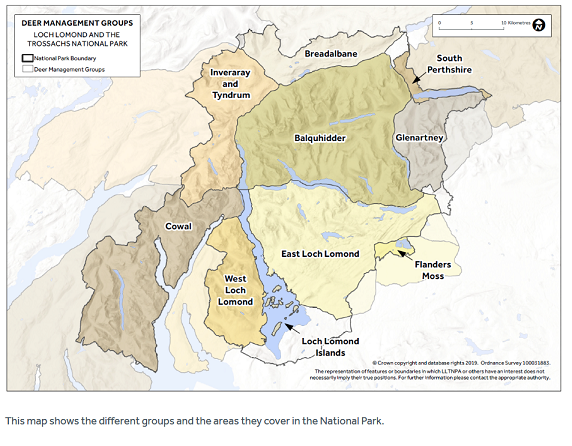
After the criticisms in my last post of the lack of transparency in the planning system, its nice to report that in other areas the Loch Lomond and Trossachs National Park Authority is showing signs of improvement. The LLTNPA’s recent publication of Deer Management Plans for the area is particularly welcome. The impact of deer is the single most important conservation issue that the LLTNPA and Forest and Land Scotland, as the largest landowner in the area, need to tackle. Its also topical given the media coverage in the last few days about how high deer numbers are preventing woodland regeneration.
Transparency about how landed estates are managing deer
Eleven months ago after I had appealed to the Information Commissioner the Loch Lomond and Trossachs National Park Authority was ordered to release much of the information it held on estate Land Management Plans (see here for issues). Unfortunately those plans that had been drawn up were generally poor and contained no useful information on deer management.
The Deer Management Plans which have now been published (see here) are a step in the right direction but generally they still don’t report what individual landowners have been doing to control deer numbers. There are exceptions which show this information does not need to be withheld from the public:
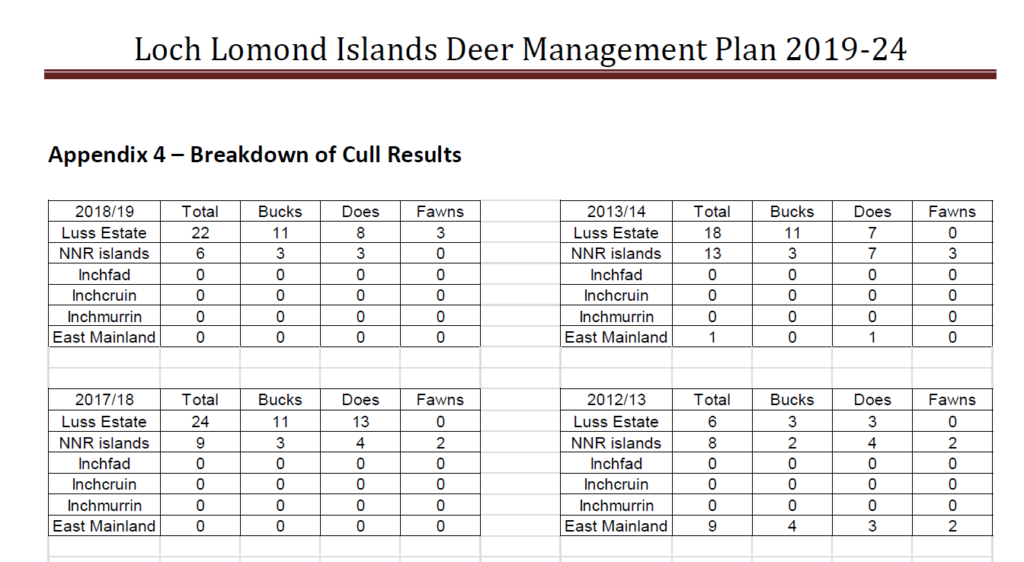
The Plan reveals that on Inchfad the deer density is one of the highest in Scotland, equivalent to 86 deer per square kilometre and that reduction in deer numbers there is the priority. However, one suspect that the only reason this information has been published is that the private landowner concerned is now keen to co-operate (well done them!).
In other areas, however, cull information is notable for the way it is NOT broken down by landholding.. This plays into the hands of the landowners who are not co-operating to bring deer numbers down and are at the root of the deer problem.
The deer problem and east Loch Lomond
In the Herald Magazine on Saturday there was an excellent article on “Scotland’s secret rainforests“, the Atlantic influenced woodland that COULD be covering much of the National Park. Kate Holl, the Woodland Adviser for SNH, explained why its been reduced to a few remnants:
“It’s simple. It’s because we have higher herbivore numbers than pretty much anyway else in Europe”
This theme was repeated yesterday in the Ferret’s coverage (see here) of the new Scottish Environment LINK Report Managing Deer for Climate, Communities and Conservation. Again the message is simple, habitats and the species that depend on them are being destroyed by deer because landowners have failed to control their numbers. This has had many knock on effects for years and is the single most important factor which will affect the Scottish Government’s ability to meet its woodland expansion targets (see here). To illustrate the scale of the problem Mike Daniels from the John Muir Trust quotes the great ecologist Frank Fraser Darling who 50 years ago said there should be 60,000 red deer in Scotland – there are now nearer 400,000. The case for action couldn’t be clearer.
So what does the Deer Management Plan for east Loch Lomond tell us there about how deer there are being “managed”?
Part of the answer to that, as the Plan shows, is that there has been NO plan until recently. The Deer Management Group collapsed in 2002 and has now been replaced by an East Loch Lomond Land Management Forum (ELLLMF) which covers a rather different area. While Forest and Land Scotland is by far the largest landowner in the area, production of the Deer Management Plan has been left to frontline staff from the LLTNPA and Scottish Natural Heritage. They appears to have done a very good job given the constraints in which they operate of publishing what information they can.
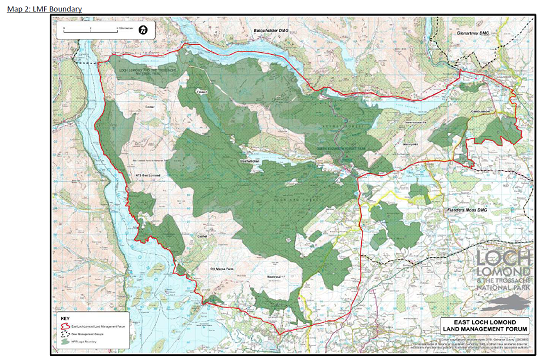
Unfortunately, basic information on what Forest and Land Scotland has done to manage deer is missing from the report – FLS don’t even report the size of their landholding unlike other landowners in the Forum though I suspect they have better data than any other landowner. Moreover, while there are references to high deer culls by FLS in the past, particularly along the east shores of Loch Lomond, more detailed culling information which would enable one to understand WHERE FLS is now culling deer is missing.
To illustrate why this is important, part of FLS’s landholding is around Loch Ard, where there were a large number of landslips following the downpour of 4th August. The number of deer that have been culled there in the last 20 years, say, might just have a bearing on WHY these landslips occurred.
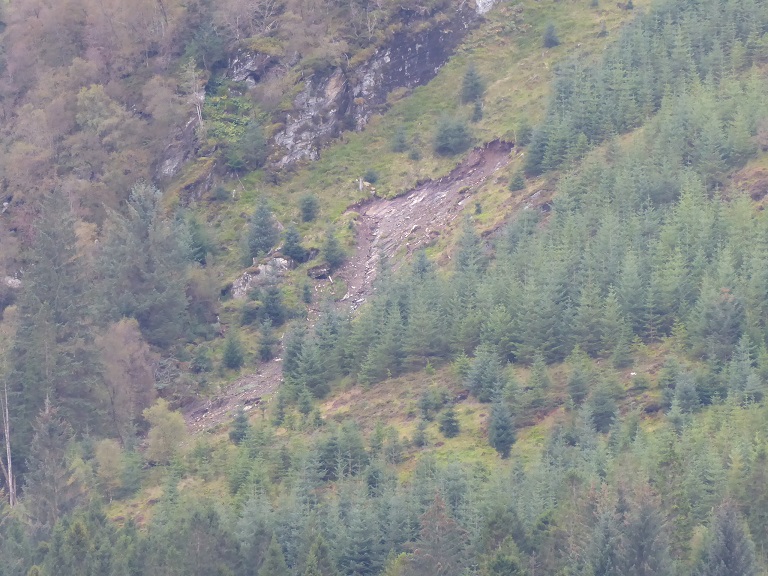
Instead of reporting numbers for each landholding, the Plan summarises data from the statutory returns that each landowner has to make to SNH on the number of deer they have culled:
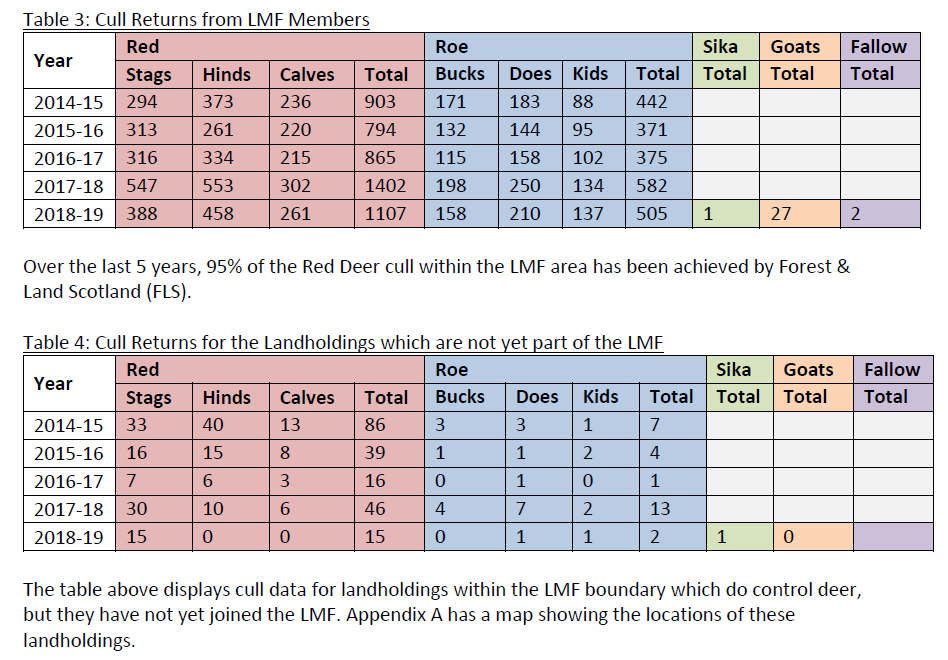
With FLS culling 95% of Red Deer, this absence of transparency clearly protects private and conservation landowners in the area: its impossible to tell which of the other 11 members of the ELLLMF culled any deer at all. Not all should have. The Forum includes among its member two holiday cottage businesses, Frenich Farm and Blairhullichan, both of which are about 20 ha and are presumably concerned about how deer eat any trees they plant.
That FLS at present is responsible for culling 95% of the Red Deer, however, does not mean they are doing enough. This is illustrated by the information in the report on the condition of designated sites in the area.
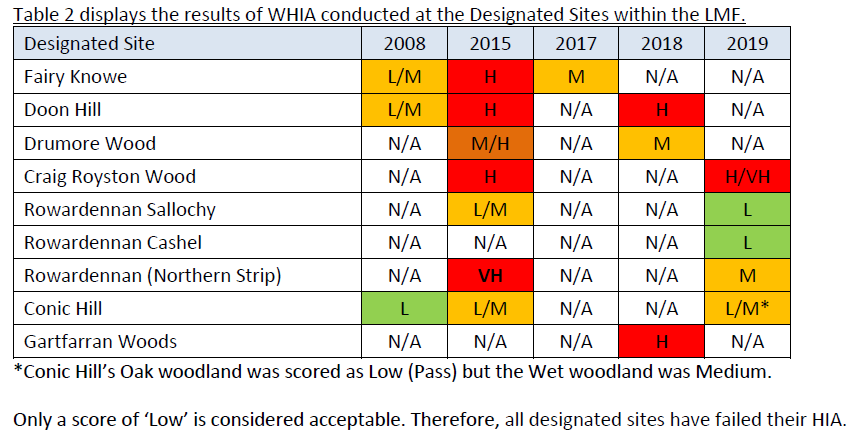
This effectively tells you that three of these designated sites are literally being destroyed by overgrazing. Being in a National Park too clearly makes very little difference.
The accompanying map – well done the staff concerned – shows is that all ten of these sites either lie on or close to land managed by FLS, which is ultimately owned by the public:
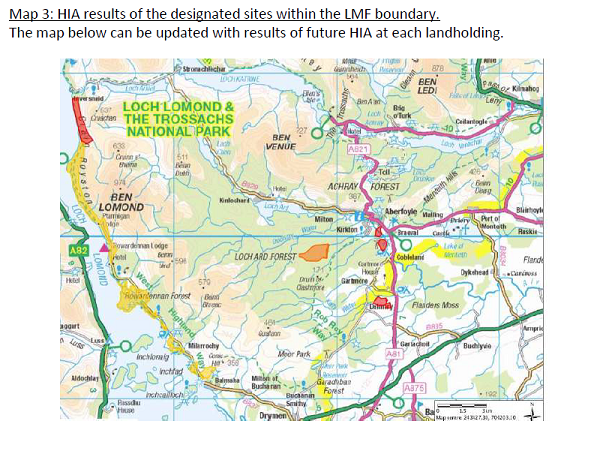
It also suggests that FLS has been significantly better at managing deer numbers along much of the east shore of Loch Lomond, as part of the restoration of Atlantic oakwoods, than it has in the Loch Ard and Loch Achray Forests where industrial scale timber production pre-dominates. Within this context the high impact of herbivore grazing on the northern part of Craig Royston woods is partly attributable to the high numbers of goats found there.
Analysis is further complicated by the landowners who have not yet joined the ELL LMF
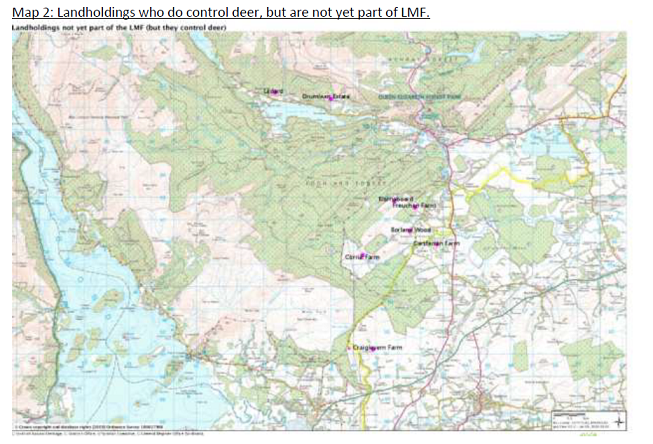
(As an aside, it may not surprise regular readers that neither Ledard Farm, owned by former Board Member Fergus Wood (see here for latest) nor the Drumlean Estate (see here) have joined the ELLLMF. The message: that landowners who find it hard to welcome walkers are usually the worst at conservation too).
The map shows a cluster of non-member farms south of Aberfoyle close to the cluster of designated sites in poor condition. The problem is that without the publication of numbers of deer culled, its impossible for the public to see which landowners, whether public or private, are failing to play their part This is not an accident. The publication of such data would make it much easier for public authority staff, such as the two who have drawn up this plan, to state publicly where action is needed.
The voluntary approach to deer management will probably never work, but neither it nor a compulsory system CAN ever work until basic information of how many deer are being culled by each landholding is made public (FOI requests to follow!).
Deer management in the National Park should be quite simple and focussed on upping the numbers of deer culled by each landowner. Instead frontline staff are forced into endless attempts at “voluntary” negotiations with landowners with both hands tied behind their back. The “Plan” for east Loch Lomond states that in future culls are to be based on further Herbivore Impact Assessments – conducted by landowners! There is some hope of that ever happening and the consequence is that nothing is planned and nothing will happen:
“At present, HIA results are not available for all landholdings; this is the information that we need to
tailor our cull efforts. In the meantime, whilst we wait on the HIA updates, it is suggested that each
landholding continues to cull at least as many deer as it has currently done in recent years.”
That’s all the landholdings that have failed to cull deer off the hook!
There will be further consequences, not just for the natural environment but for humans driving round in their cars (there is almost no public transport in the area):
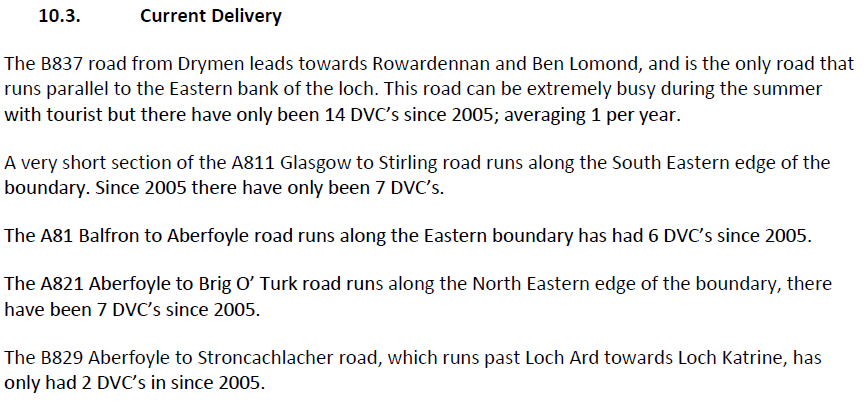
Unfortunately, despite all the documented damage to the natural environment and to people, nothing ever appears to provide a sufficient reason to force landowners to reduce the numbers of deer.
What next to tackle the deer problem in the Loch Lomond and Trossachs National Park
This post has used the Deer Management Plan for east Loch Lomond to show that the current plans to tackle deer numbers in this area are totally inadequate. That should be a cause of concern, shame and embarrassment to the public authorities responsible, Forestry and Land Scotland, SNH and the LLTNPA.
The problem is not the frontline staff concerned, who appear to be doing their best, but the system in which they are forced to operate. Large amounts of effort go into delivering almost no change on the ground. Indeed in some areas the impact of deer continues to get worse.
The publication for Deer Management Plans across the National Park should nevertheless be seen as a very positive initiative. The east Loch Lomond Plan shows how they might help promote informed debate (parskwatch will consider the Plans of other Deer Management Groups in due course) and could be used by local communities suffering from high deer numbers. The Plans are are a necessary step for ALL landowners to be held to account. Their use, however, will be strictly limited until the LLTNPA and SNH insist that the cull data for ALL landholdings is made public as a matter of course.
Unfortunately, while the introduction to the LLTNPA’s webpages on Deer Management is quite sensible, its then undermined by the aims which the Park appears to have adopted:
“Deer management, based on sound ecological principles, is an essential part of managing land in a sustainable way. It is mainly the impact of deer that land managers are concerned with, rather than the actual number of deer. It is important that numbers of deer are not allowed to increase to levels where there is an adverse effect on their welfare or their habitat [Comment: we are well past that stage]. Deer belong to no-one and therefore represent a shared resource for the people of Scotland. The right to control and manage deer, however, is held by the owner of the land upon which they cross. Deer range over land ownership boundaries and it is through the Deer Management Groups in the Park that land managers work together to manage the deer collaboratively.”
This conceptual framework could have provided for an approach such as is being taken at Glen Feshie, where deer numbers have been continuously reduced with spectacular results. However, the LLTNPA then precludes such an approach in the first two aims it states it has adopted for working with Deer Management Groups (its not clear where these were agreed):
- “A mosaic of deer densities allowing different deer management objectives to be achieved in different parts of the Park” Comment: so how can one area have high deer density and the next low deer densities when deer respect no boundaries? This is not just daft, its totally inappropriate for a National Park which is supposed to put conservation first.
- “A deer management planning process which seeks agreement from all interested parties on what deer densities should be“. Comment: again, this is an impossible objective, as demonstrated by the numbers of landholdings which are not even members of the east Loch Lomond Land Management Forum.
These two aims just play into the hands of landowners.
The LLNTPA’s publication of Deer Management Plans for the National Park provides further convincing evidence that, whatever the efforts of frontline staff, it will get nowhere until a regulatory approach is taken as in other countries.

There will be no significant improvement in deer management until the statutory regulation of deer numbers across the whole of Scotland is introduced, as recommended in the recent report published by Scottish Environment LINK. Managing Deer for Climate, Communities and Conservation. Our politicians need to read this report, act on its recommendations and ignore Richard Cooke, chairman of the Association of Deer Management Groups, who repeatedly misrepresents those who are seeking changes by claiming such representations want trees but no deer. A walk across Balmoral Estate and the other five estates which comprise the Executive Steering Group of the South Grampian Deer Management Group demonstrates why habitat degradation continues, despite decades of futile effort to persuade the landowning members of this DMG to change their ways. Richard Cooke represents these estates, also demonstrating how ineffective and useless the ADMG is. The Royal Family needs to tell him that, to continue speaking on their behalf, cooperation with Scottish Environment LINK is required, not a continuing misrepresentation of the efforts of LINK and others to drag deer management in Scotland into the 21st Century.
All deer management groups in Scotland report their culls progress to Naturscot. They take their responsibilities seriously. As such, open range deer numbers tend to be well managed overall, but the problem lies at the State Forest’s gate, where, despite trying for thirty years to ‘manage’ the numbers to sustainable levels, the fact is that deer numbers are increasing robustly within the NFE. Insanity is defined as trying the same thing over and over, expecting a different result. High tech solutions are proposed, but simple, low tech, tried and tested methods (widely deployed in the private sector, for they cannot escape opprobrium if found wanting) are eschewed. Mismanagement and neglect of basic infrastructure, coupled with examples of poor forest design abound, and are repeated from one cycle to the next. This is typical blinkered group-thinking by those who purport to set the standard, but in fact fail miserably by all metrics. Poor design, over reliance on office-bound computer boys rather than professional woods men (mostly let go now in favour of contractors for all manner of tasks), and the result of this balance-sheet management approach shows in the utter failure to address this problem of their own making. Wrong type of guy doing the ‘thinking’, coupled withinsufficient numbers of those tasked with the coal-face work. It’s hardly rocket science to see where these problems arise, but the ‘reward for failure’ culture is strong in many government agencies, FLS being no exception. To cap it all, we pay for this failure, and get badly designed low quality cellulose short rotation crops, a parody of what a proper forest should be. Shameful.
Have your read the report of the Deer Working Group? The National Forest Estate comprises 9% of the land but is responsible for 30% of the national deer cull (see below)? How do you explain that? The problem lies with sporting estates which have encouraged deer numbers to grow, prevented natural regeneration of woodland, destroyed peatland and have created huge expense for the public purse (forestry fences, peatland restoration, unnecessary tree planting etc etc)
“51 The largest single contributor to the annual cull totals is Forestry and Land Scotland (FLS), which manages Scotland’s National Forest Estate (NFE) on behalf of Scottish
Ministers.48 The NFE covers approximately 650,000 hectares or 9% of Scotland’s land area.49 FLS publishes its annual cull totals and Figure 32 in Section 14 of this Report
shows these totals for each deer species for 2009-2018, including the cull totals from its predecessor, Forest Enterprise Scotland, as a percentage of the national cull statistics.
FLS generally accounts for relatively high proportions of the recorded roe and sika deer national culls, around 40% and 45-50% respectively each year, compared to red deer
(c.15-20%) and fallow deer (c.20-25%).
52 FLS is a public body and culls around 30% of Scotland’s recorded cull total each year, while other public bodies generally contribute another few percent, for example, from
SNH’s land and the Scottish Government’s crofting estates.50 This indicates that the public sector is currently carrying out around a third of the recorded annual cull of wild
deer in Scotland each year.
What’s the difference between deer being killed and stoat and weasels being killed, not long ago you were against trapping .Stoat and weasels were being trapped to potected ground nesting birds
Good question Bill. Part of the answer is deer no longer have natural predators. If we had wolves, which would predate on red deer, and lynx, which would predate on roe deer, I would be against any culling of these species in our National Parks. In the absence of wolves and lynx, for a long time humans replaced them as predators but the gradual tightening of hunting laws means that there is very little hunting “for the pot”. The landowners, who effectively now have sole rights to hunt and enforce this through the poaching laws, have then allowed deer numbers to increase to their current very high levels, in part because estates have been valued by the number of stags found on them. These high numbers of deer have turned much of Scotland into what Fraser Darling called a wet desert and prevented what woodland there is from regenerating. Deer are therefore impacting not on any one species but the entire ecosystem.
The situation with deer is very different to that of stoat and weasel. They still have natural predators, foxes, pine marten and raptors, or would have if these species were not also widely persecuted. The main reason they are being culled is to increase numbers of red grouse, pheasant and red legged partridge so humans can shoot these species. In other words they are being culled not to benefit habitats but particular species. There is no doubt that stoat and weasel do predate on waders nests but its clear they are not the main factor impacting on wader breeding otherwise the increased intensity in trapping would have resulted in a signficant increase in waders. In fact wader numbers are dropping and the main reason for this is other factors (e.g agricultural intensification).
Deer play a key role in natural ecosystems and reducing numbers by culling is very different to trying to eliminate a species entirely, which is what effectively many estates are trying to do with stoat and weasel. There is a clear distinction between culling and persecution.
Leave the animals alone. Humans are one of the most invasive and problematic species on the planet. Yet humans think they have the right to take away other animals right to life because you have labelled them as a problem? Nothing but EVIL Monsters.
The problem is that with humans having removed all the natural predators on deer, if they are left, their numbers increase and as they do so they destroy the habitats on which a multitude of other animals depend. Do you think its right that other animals die because deer browsing leaves them with no food/habitats? Isn’t that as great an evil?
I live on a croft. As I look through this window at this very minute right now, I see 8 young stags grazing our field and the field of our neighbour 50 yards away. It has been like this all summer with so many northerly winds, vagrant deer seek shelter here, the space we have near surrounding homes is too restricted to cull them. This year there is no hay or haylage crop for winter feed for livestock on either croft. Burgeoning numbers of deer have already consumed it.